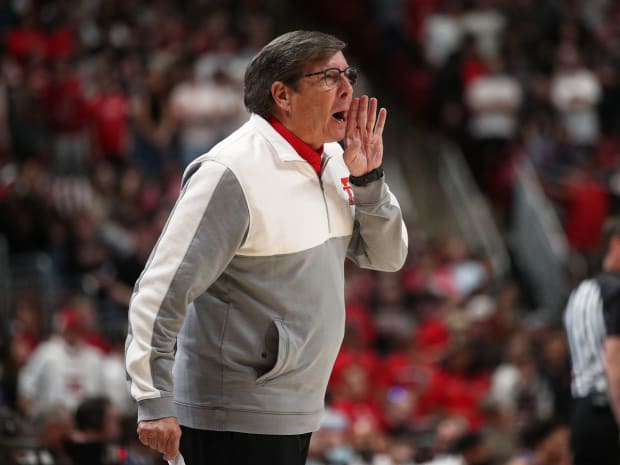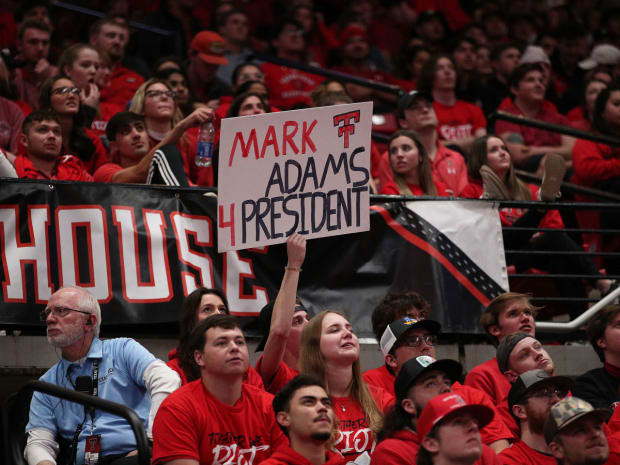Make your way out to west Texas, through the plains and the wind farms, hours from Dallas and Austin, and you’ll eventually hit what they call the Hub City. The connective tissue of numerous farming communities, Lubbock stands among the sleepier towns in the Big 12. But come game days at United Supermarkets Arena, the city is nothing of the sort.
In a sentence unimaginable even a decade ago, Texas Tech stands as one of men's college basketball’s top programs over the last five seasons. The Red Raiders have reached the NCAA tournament in each of their last three opportunities, registering their first Elite Eight appearance in 2018 before losing to Virginia in the national championship in 2019. The success has bred one of the sport's most raucous atmospheres. Games in Lubbock in recent years resemble Lawrence, Kan., or Lexington, Ky., an event not just for the city’s residents, but the collection of surrounding towns as well.
Mark Adams is a son of one of those towns. Hailing from Brownfield, Texas (39 miles southwest of Lubbock), Texas Tech’s coach grew up in a traditional fashion. His father, Tom, was a farmer, and when Mark wasn’t in school, he spent plenty of mornings and nights tending to his family’s property. Adams speaks reverently of his dad, a man he calls “not just a farmer, but a philosopher.” But as Adams’s college years approached, one thing was clear: His interests didn’t lie in the family business.

Michael C. Johnson/USA TODAY Sports
“I grew up on a farm, and the hardest work I’ve ever done is being there from sunrise to sunset and even after,” Adams says. “One time as I got older, I told my dad, ‘The only thing I learned about farming is I want to get off the farm.’”
It’s safe to say Adams has left the farm, though he hasn’t ventured too far from the region he calls home. Save for a stint as an assistant at Arkansas–Little Rock in 2015 and ’16, Adams’s entire coaching career is confined to the Lone Star State. He got his first taste of coaching as a student assistant for Texas Tech coach Gerald Myers in the late 1970s, and Adams began his professional career at Clarendon College—two hours north of Lubbock and just an hour west of the Oklahoma border—in ’81. Adams’s journey through the next four decades lacked the glamour of a typical coaching rise, but it didn’t lack in success.
Adams went 100–39 in two seasons at Wayland Baptist, reaching the NAIA title game in 1985. He won 108 games at West Texas A&M from ’87 to ’92, and his proudest career accomplishment came when he and current Suns forward Jae Crowder led Howard College to the 2010 NJCAA championship. Yet even as Adams stacked his professional accomplishments, one career goal eluded him. The head coaching job in Lubbock often felt like a distant dream.
“[Texas Tech] was always my dream job, but after being at Howard College and some other places, I didn’t view the head job at Texas Tech as a reality,” Adams says. “I wanted to become a D-I head coach [again], but this to me felt like a dream I was never going to fulfill.”
Chris Beard can take a large share of credit for bringing Adams back to Lubbock. The current Texas coach hired Adams as an assistant at Arkansas–Little Rock in 2015, and after the team reached the second round of the NCAA tournament in ’16, the duo moved to the Big 12 as Beard replaced Tubby Smith in Lubbock. Adams didn’t have the head job just yet, but he was no bystander in Texas Tech’s rise up the collegiate ranks.
The Red Raiders weren’t an immediate success upon Beard’s arrival. They posted an 18–14 record with a 6–12 mark in the Big 12, a season Adams remembers as “humbling.” A serious jump in competition provided a significant challenge, one exacerbated by the lack of recruiting appeal traditionally associated with Texas Tech. An overnight talent influx wasn’t feasible. Changing the program’s fortunes required a schematic adjustment.
Nov. 19, 2017, serves as a demarcation point in Texas Tech history. What is otherwise remembered as a sleepy early-season matchup against Northwestern is recalled by Adams as a moment the program made a monumental switch. After an offseason of film analysis and self-reflection, Adams devised a scheme that transformed Texas Tech’s defense. He instituted the now-famous no-middle defense, in which the Red Raiders shift opposing offenses toward the sideline and baseline at every opportunity. With the new defense in tow, the Red Raiders cruised, holding the Wildcats (who had reached the second round of the Big Dance the year before) to just 49 points in a blowout victory.
The win served as confirmation of the scheme’s effectiveness, as did the months that followed. Texas Tech jumped to No. 4 in defensive efficiency in 2017–18, per KenPom, and it reached the Elite Eight following a double-digit victory over a 30-win Purdue team in the Sweet 16. The run propelled Adams to a degree of nationwide notoriety, the right-hand man behind one of college basketball’s rising coaching stars.
Adams resembles more of a chemistry teacher than an elite coach at first glance. He often opts for a pullover or sweater-vest over any sort of resplendent, Jay Wright–esque suit, and he speaks with the soft drawl you’d expect of a 65-year-old Texan. But make no mistake. Below Adams’s congenial exterior lies a fierce competitor, one whose intensity can be dialed up when called upon.
“He’s a hard-nosed guy. He’s gonna push you,” Texas Tech junior Kevin McCullar says. “He makes sure we know winning games in the Big 12 starts and ends on the defensive end.”

Michael C. Johnson/USA TODAY Sports
Texas Tech’s players speak with a sense of near-indoctrination as they detail their team’s identity. McCullar notes a stated goal to be the “toughest, most physical team on the court.” Transfer forward Bryson Williams compares his current team to the ‘Grit-N-Grind’ Memphis Grizzlies of the 2010s, a group notorious for its hard-nosed defense. Both McCullar and Williams cite resilience as a key tenet of the program. They and their coach are consistent in message and tone, bringing a cohesion often unseen in modern college basketball. Listen to Williams brim with intensity when discussing the Red Raiders, and you hear a player serving as a clear extension of his coach.
“We don’t take no excuses, we don’t look for no shortcuts. We don’t do anything on the short side of the stick,” Williams says. “We don’t take the path of least resistance. We go right through it.”
Adams remembers a healthy amount of back-and-forth with Beard over the duo’s five-year run together in Lubbock, with plenty of debates centering on the team’s reliance on the no-middle scheme. “I’m not sure coach Beard was as totally committed to it as I was,” Adams says. “It took a while to convince our coaching staff that this is what we needed to do.”
In April 2021, the debates ceased. Beard left Lubbock to fill the coaching vacancy in Austin, replacing Shaka Smart after the Longhorns failed to win a tournament game for the seventh straight season. When the head job at Texas Tech opened, Adams was asked by athletic director Kirby Hocutt if he’d like to interview for the gig. Adams’s answer was succinct and sufficient.
“I told Kirby, ’I’ve been interviewing for this job for the last five years.’”
Beard put a full-court press on Adams in an attempt to bring him to the state’s capital, but no salesperson could pull Adams from the job he’d coveted for decades. Adams was named Beard’s replacement five days later, and the program has largely hummed along despite the cloud of uncertainty that loomed in the immediate interim after.
Key scorers in McCullar and Terrence Shannon Jr. remained with the program following Beard’s departure, with McCullar adding he “didn’t even consider entering the [transfer] portal.” A process that frankly could have doomed Adams has ultimately paid significant dividends. Williams leads the team in points per game after stints at Fresno State and UTEP. Davion Warren has added a dose of backcourt firepower after two years at Hampton. Adams played a pivotal role in turning Texas Tech from an also-ran into a consistent contender. He’s now reaping the benefits of the culture he’s created.
Texas Tech has largely performed to expectations in Adams’s first year as head coach. It's weathered a number of COVID-19 and injury absences to sit at a healthy 16–5 and 5–3 in the Big 12 entering Tuesday night, including a narrow double-overtime loss at Kansas on Jan. 24. The Red Raiders sit No. 4 in the nation in adjusted defense, per KenPom. They rank in the top 15 in turnovers forced and opponent field-goal percentage.
And while another deep March run would certainly be welcome by those in Lubbock, the 2021–22 season in the Hub City could be defined by the events of Tuesday night. Beard and the Longhorns were booed as they departed their team bus on Monday evening, and a ruder welcome is expected on Tuesday. The Lubbock area is transformed when Texas Tech takes the floor. Tuesday night will provide the starkest example.
Adams is quick to dim the stakes of the matchup, highlighting the game as a learning opportunity more than a must-win. He chuckles at the atmosphere that awaits, with a certain bewilderment at both Texas Tech’s place in the national conversation and his own role atop the program. To Adams, leading the way in Lubbock stands as not a stepping stone, but a career peak. Adams didn’t need to venture far from Brownfield to achieve his life’s dream. And he’s not done just yet.
“We represent the people of this area,” Adams says. “I just hope we can make them proud.”







